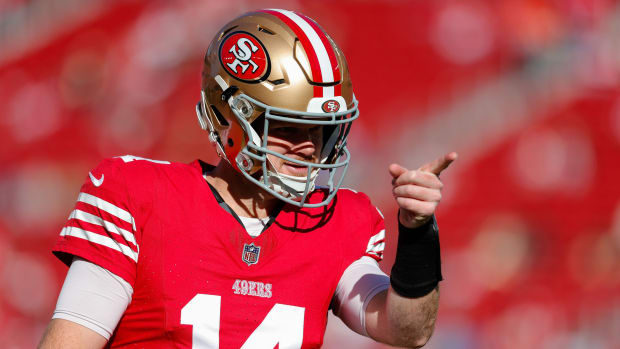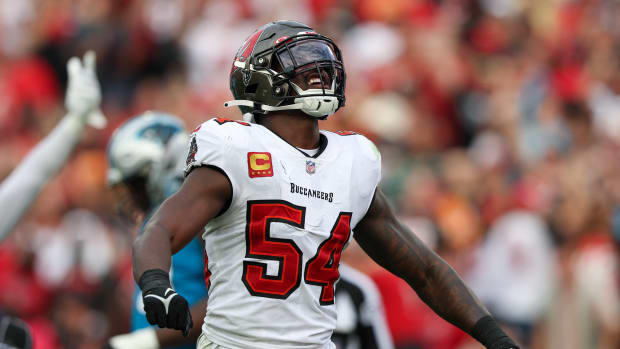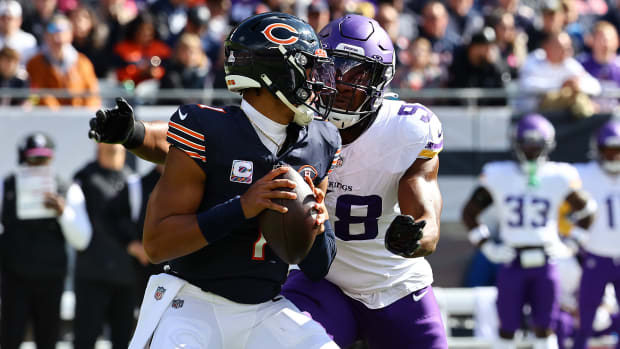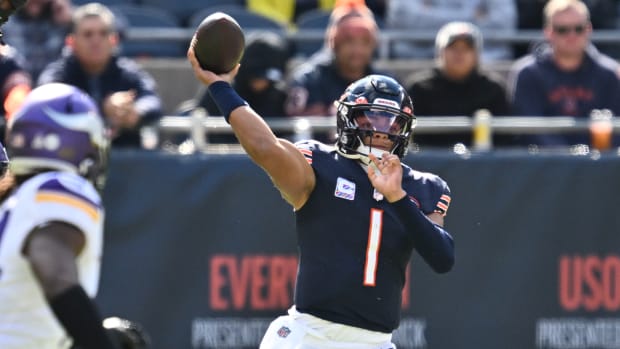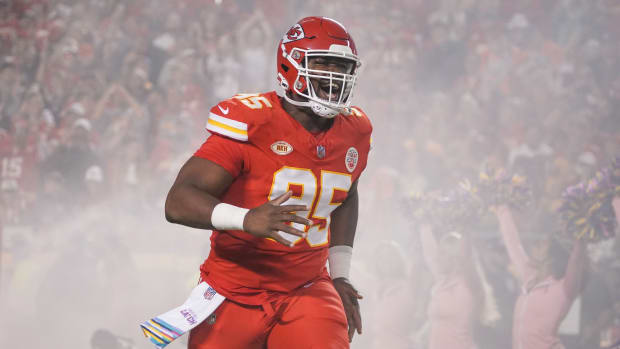The High School Game: What’s Changed in the Concussion Era
In 2013, the inaugural year of The MMQB, we dispatched three reporters to three U.S. locations to gauge the state of the game at the high school level as the concussion crisis in football grew. We wanted to learn how players, coaches and parents were dealing with the flood of new information on head injuries and their effects, and to what extent the approach to diagnosing and treating concussions was changing for the better. These stories, part of a series that explored the causes and effects of head trauma in the sport, were published a month after the NFL and more than 4,500 ex-players agreed to a $765 million court settlement over the league’s handling of concussions going back decades.
What we found in three towns in Georgia, Kansas and Pennsylvania was a collection of athletes, parents and coaches learning new terms such CTE (chronic traumatic encephalopathy) and coming to grips with the changing landscape of America’s most popular sport. There had been no sea change in 2013, but there were hints that it was coming. Back in 2013:
· I traveled to Smith Center, Kans., the geographical middle of the U.S., where fans were pushing back against a new kind of personal foul: targeting the head. “Football is a way of life out here,” Traci Oliver told me while her son recovered from a concussion. “Of course my heart stopped when he laid on the ground last week, but he got up.” Also in Smith Center, the scarcity of certified athletic trainers in the area meant games often were played without experts on hand who were trained to spot concussions and pull kids from games.
· A mother of a student at Archer High in Lawrenceville, Ga., spoke of the headaches that bothered her son, a linebacker, since ninth grade. “I pray before the game, I pray during the game, I pray after the game,” Stacey Lee, a nurse, told The MMQB’s Emily Kaplan. “That’s how I get through it.”
· The MMQB’s Andy Degory went back to his alma mater, Indiana (Pa.) High, in the heart of football country, and met Jim Stapleton, a dad whose son had experienced three concussions and was still playing: “We’re guys. It’s football. We do what we do.”
As The MMQB prepared to dive back into the world of high school football, we wondered: What happened to those communities we dropped into three years ago? Quite a bit, it turns out.
* * *
DeGory, who played football at Indiana, Pa., and later at Colgate, wrote in 2013, “It’s hard to imagine the traditional high school scene I witnessed on this Friday night changing anytime soon, especially in Western Pennsylvania, a region that has produced the likes of Revis, Marino, Ditka and Namath.”
But big changes have come in the form of declining football participation. What’s more, according to new head coach John Allen Snyder, a rash of players are mimicking and claiming concussion symptoms as a means of getting out of practice.
“Kids have realized how to work the system,” Snyder says. “When it’s hot and practice is hard and coach is dogging you, it’s really easy to say, I have a headache. We don’t want to get sued. As soon as we hear those words, it’s out of our hands. Send them to the trainers. And it’s only gotten worse in these last three years.
“Then a kid really gets a concussion, and it’s almost like crying wolf. It’s scary because it can really do damage to this game that can be so important for young men and now women who are playing.”
Snyder has 46 students in his varsity and JV programs at the moment; he plans to shutter his freshman program after this season due to lack of participation, a trend sweeping Indiana’s eight-team section. He’s canceled three JV games this year because Indiana didn’t have the numbers to compete. He’s had conversations with parents who fear their children won’t be able to remember how to get home after school if they play football—a far cry from football enthusiasts such as Stapleton (“We’re guys. It’s football”), whose two sons are now playing in college.
“The number of dads and moms who are like that, old-school, is dwindling,” Snyder says.
Local lawyer David Zimmerman, who helped launch the school’s lacrosse program in 2009, was interviewed three years ago and compared attitudes about football and concussions to attitudes about smoking cigarettes 25 years ago. The tide, he insisted, was soon to shift. Three years later, the high school lacrosse program at the high school with fewer than 900 students boasts steady participation of 50 athletes yearly. Zimmerman stresses a fundamental difference in the way the two contact sports are played.
“I think you still have some guys out there playing football with the mindset that they want to hurt somebody,” Zimmerman says. “We get football players in lacrosse, and its hard to get across to them that most of the time you want to minimize the physical contact in the interest of winning.”
In conversations with parents at football and lacrosse games about the risks of concussions, Zimmerman sees a clear delineation between the thinking of those with college degrees and those without. “The people who use their brains for a living, who plan on their children making a living based on a professional degree, seem to be more concerned,” Zimmerman says.
* * *
At Archer High in Georgia, where Kaplan spoke to parents, players and coaches in 2013, our report painted the picture of an upper-middle-class Atlanta suburb doing everything in its power to educate families and coaches and prevent concussions. The Concussion Institute at nearby Gwinnett Medical Center was then in its infancy, and has since become the primary resource for Gwinnett County student athletes in concussion treatment.
Dr. Adam Shunk, neuropsychologist and former NCAA and U.S. champion high jumper, says the institute deals less and less with students who are being pushed to admit they have a concussion, and more often with students eager to rule out a brain injury.
“When people came into the office a few years ago it was pretty obvious they had [a concussion], and someone was pushing them to get checked out,” Shunk says. “Now they’re actually having them come in to rule out a concussion.”
Shunk has a sense that the frequency of students hiding concussions—a phenomenon Kaplan probed in 2013—is dwindling, and the institute is in talks to create a survey to find out, among other questions, if that impression is true.
New laws in Georgia that specifically require medical clearance for a return to play after a concussion made the road to education easier in Gwinnett, as has the changing climate in general, according to former county athletic director Mike Emery, now the A.D. at a small Atlanta private school.
“The laws, the NFL changes, the “Concussion” movie—it all builds together to create the sense that you can’t fight this thing. It’s real, and we have to deal with it,” Emery says.
Gwinnett hasn’t seen the type of participation decreases reported in Indiana, Pa., at the high school level, but Emery says youth leagues have taken a hit, and parents who allow their kids to play at a young age are taking every precaution. This fall saw the release of a federally approved pediatric version of the ImPACT baseline test for concussion evaluation.
Says Shunk: “We’re even seeing kids as young as age 5 coming in for concussion evaluation. Everyone has become more vigilant.”
* * *
In Smith Center, Kans., a town that is home to fewer than 1,700, change in attitudes about head injuries and available resources move at a slower pace than what we found in Pennsylvania and Georgia.
“I have not yet had a kid or parent say they’re not going to play football because they’re afraid of concussions,” coach Darren Sasse says. “I don’t see a big pushback on that yet. I read articles about it, and they say in bigger towns kids are going more towards other sports.”
When we visited in 2013, Sasse was in his first season on the sideline as the head coach. He’d replaced the Kansas prep legend Roger Barta, who since 1978 had amassed a 323-69 record and won eight state titles. Sasse reached the state semifinals last season and begins the playoffs this week.
Two weeks ago, Smith Center saw its game cut short with six minutes remaining due to a car accident nearby, which occupied both of the town’s ambulances (Smith Center was awarded a 39-0 victory). Though it won’t play without an ambulance on site, the team still occasionally plays games without a certified athletic trainer on either sideline. In lieu of trainers, coaches are asked to evaluate players for concussions after completing an online course at the beginning of the season.
In 2013 we wrote about athletic trainer John Uelmen of Kearney, Neb., who logged upwards of 800 miles a week in his Toyota Corolla serving 11 schools in Nebraska and Kansas. Despite a lack of outcry for proper health coverage at games, Uelmen has noticed minor changes in the culture of the game in the heartland.
Over the past three years, he says, he has yet to run into a case where a concussed student went undiagnosed and finished a game, an improvement that he attributes to liability concerns among coaches. In his travels he’s heard of families keeping their sons out of football due to concussions about five to 10 times a year at his 11 schools. He believes tackling techniques have improved at the high schools he serves, a result of an emphasis on targeting calls by officials in both states.
“The refs are pretty quick to call anything that is targeting,” Uelmen says. “Probably last year we started seeing it more frequently, about once per game.”
At Smith Center, the mother who described football as “a way of life” in 2013 ended up keeping her youngest son, Dalton, out of sports entirely after he suffered two shoulder injuries, a pelvic injury, two fractured ankles and a concussion in both wrestling and football. He still helps out with the football team as a film assistant, and his parents still attend games.
And they’re starting to warm up to the targeting penalties, too.
“Throwing people out for helmet-to-helmet contact is a great thing,” says Dalton’s father, Lee Oliver, a real estate broker and auctioneer. “Maybe I’m a little too open about these things, but that’s the truth.”
Question? Comment? Story idea? Let us know at talkback@themmqb.com.




































